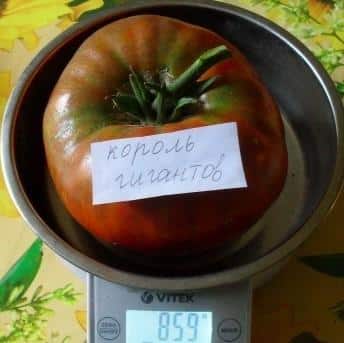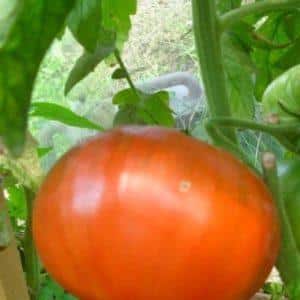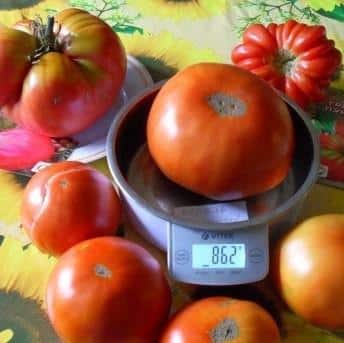A delicious tomato for lovers of large fruits: the “King of Giants” tomato - how to grow it yourself and where to use it
The tomato variety King of the Giants was developed relatively recently, but has already gained popularity among vegetable growers. The variety is loved by gardeners both in the southern latitudes of Russia and in the northern latitudes. And although the King of Giants is whimsical and requires special care, its high yield more than compensates for this disadvantage.
Today you will learn how to properly plant and grow large King of Giants tomatoes in your garden.
Description of tomato variety
Russian breeders brought this tomato variety from Siberia only in 2010.
King of the Giants is an indeterminate, mid-season variety. The height of the plant reaches 1.5-1.6 m in open ground, and in greenhouse conditions it grows up to 2 m. If you follow all the rules and planting dates, tomatoes will begin to ripen 110-120 days after the first shoots.
Distinctive features
 Among the characteristics of the variety, gardeners note resistance to most diseases and high yield. The fruits tolerate long-term storage and transportation well.
Among the characteristics of the variety, gardeners note resistance to most diseases and high yield. The fruits tolerate long-term storage and transportation well.
The plant requires special care and attention. Regular pinching and timely garters are required. This variety is also very dependent on sunlight and heat.
Another feature of this tomato is that it is better to pick the fruits slightly unripe. Once overripe, the King of the Giants tomato fruits quickly lose their appetizing appearance and burst. This is especially inevitable with excessive watering.
Fruit characteristics and yield
The shape of the fruit is round and slightly flattened. Color – bright red. The tomato pulp is fleshy and juicy. The fruits have no more than eight chambers inside. The skin of the “royal” variety is dense.
The average weight of tomatoes of the King of Giants variety is 450-600 g. However, in greenhouse conditions, if all recommendations are followed, larger fruits weighing 800-850 g grow.
The King of Giants variety is also distinguished by its excellent taste: the taste of the fruit is sweet, slightly sour.
How to grow seedlings
This variety of tomatoes is mid-season, but if desired, you can speed up the ripening process. To do this, seeds are sown in late February-early March. But in this case, additional artificial lighting is created for them. If you sow the seeds at the end of March, you can do without additional light.
Seed preparation
To speed up germination, do the following:
- Pour some warm water into a flat bowl.
- Place a napkin on the bottom.
- Spread out the seeds.
- Cover the top with a napkin. The seeds should be moistened with water, but not floating in it.
- Wrap everything in a plastic bag and place in a warm place (25-26 degrees) for 2-3 days.
- After the root shoots appear, the seeds can be sown in the ground.
Important! Purchase seeds only from trusted manufacturers. In the future, collect seeds from the largest and healthiest fruits of your harvest and process them yourself. This way you will achieve better results.
Container and soil
It is better to prepare the soil mixture in the fall. To make the mixture, use:
- garden soil taken from under deciduous trees;
- compost made from plant residues (not nightshades);
- humus from pig, cow or horse manure;
- coarse river sand, free of clay.
To prepare the soil, mix all components (except sand) in equal proportions. Add sand at the rate of 1 kg per 1 bucket of mixture.
For 10 kg, take 2 tbsp. l. ammonium nitrate and superphosphate and 0.5 kg of furnace ash. After preparing this mixture, let it brew for 2-3 weeks.
If you can’t prepare the mixture yourself, purchase universal soil for seedlings. Such purchased land has many advantages:
- has good air and water permeability;
- enriched with minerals;
- balanced in acidity;
- disinfected;
- tested for pests.
Sowing
It is allowed to plant seeds in one container, followed by mandatory picking into individual glasses.
Step-by-step instructions for sowing tomatoes:
- Fill the container with soil mixture.
- Compact.
- Place the sprouted seeds at a distance of 2-3 cm from each other.
- Sprinkle with soil 1-1.5 cm.
- Lightly compact.
- Use a sprayer to pour water 2-3 degrees warmer than room temperature.
- Cover with film or glass.
- Place the container with the seeds in a warm place. Comfortable temperature for germination of the King of Giants is 25-26 degrees.
Growing and care
Prepared seeds are sown in boxes two months before transferring to the ground. Before seedlings germinate, the boxes are covered with glass or film and kept at a temperature of +25-26 degrees. Then it is reduced to +17-18 degrees. Seedlings are demanding on lighting conditions.
Important! At the initial stage, do not water the seedlings. Turn the film/glass over or remove it for a short time every day - this will allow the seedlings to be ventilated and maintain optimal humidity.
How to grow tomatoes
In open ground, the King of Giants tomato is grown only in the southern regions of our country. In the middle zone and northern regions it is kept only in greenhouse conditions. But even in the south, the beds will still have to be covered with film to create a certain microclimate.
Choosing a location for a greenhouse is similar to choosing a location for planting seedlings.
Planting and care
Before planting the seedlings, prepare the holes and water them. Place plants with thick, strong stems straight into the holes, and those with weak ones - slightly at an angle. Plant King of the Giants seedlings in open ground only after frosts have passed and the soil and air have completely warmed up.
The planting pattern is 50 cm by 40 cm (at least 50 cm between rows, 40 cm between holes), with a planting density of 3-4 plants per square meter.
Basic care for this variety consists of the following:
- Feeding tomatoes with nettle infusion, manure and “Superphosphate”. Nitroammophos should be used as complex fertilizers.
- Abundant and regular watering followed by loosening the soil around the plant bush.
- Tying and pinching tall plants into one or two stems.
Features of cultivation and possible difficulties
Planting scheme – 2-3 bushes per 1 sq.m. More dense plantings should not be done, since this tomato requires space for nutrition and good fruiting. Immediately after this, the bushes are watered and the soil is mulched.
The plant is formed into one or two stems. Stepchildren are removed in a timely manner, preventing them from growing.
Like all large-fruited tomatoes, the indeterminate King of the Giants needs good lighting, warmth, regular feeding. Tomatoes are fed three times a season, alternating organic and mineral preparations.
Important! When planting, it is imperative to form a support system. As soon as the shoot grows, it is tied up. In the future, carefully observe the plant and fix it at the support as soon as the stem begins to bend under the weight of the fruit.
For successful growth, development and fruiting, the King of Giants tomato is watered abundantly. It is recommended to regularly loosen the soil under the plants. You should also remove stepchildren in a timely manner, without waiting for them to grow excessively.
The nuances of growing in open ground and in a greenhouse
Change the location of tomatoes in the garden every three years. In open ground, it is good to plant this variety of tomato after cucumbers, zucchini, carrots, cauliflower, parsley and dill. The soil after these crops is favorable for the growth of tomatoes.
When choosing a place to plant tomatoes, consider its good lighting and protection from the wind. If you grow a plant in the same greenhouse every year, dig up the soil in the fall, be sure to add mineral fertilizers and humus.
Diseases and pests
Diseases that regularly affect other tomato varieties are not terrible for the “royal” plant. Of the pests, only the whitefly can harm it. When growing tomatoes in greenhouses, it is necessary to monitor humidity levels and temperatures.
For prevention, experienced vegetable growers advise regularly spraying plantings with herbal infusions:
- Grind 100 g of dandelion and add a liter of water. Leave the solution for a week.
- Finely chop 150 g of garlic or pass it through a press. Infuse in 1 liter of water for at least five days. Whiteflies do not like the smell of garlic.
Important! Such infusions will help if whiteflies have just appeared in your greenhouse and there are still a few of them.Otherwise, special drugs will help stop the invasion. for pest control. Use them according to the instructions and do not forget about personal protective measures - rubber gloves and goggles.
Harvesting and application
This variety has high yield. With proper care, one tomato bush can produce up to 8 kg of fruit. Considering that per 1 sq. m of plot, it is recommended to plant 2-3 plants; from such an area you can harvest up to 24 kg of tomatoes.
How to use
The King of Giants tomato is consumed both fresh and in salads. A variety of sauces are made from this variety of tomatoes.. They are not suitable for blanks in their entirety because they are too large.

Marinate or can tomatoes The King of the Giants will not work in pieces either - during the heating process, their flesh “spreads”. But they are great for ketchup or lecho. Juice is also made from these fruits.
King of the Giants tomatoes contain a large amount of useful substances, microelements and vitamins with a minimal acid content. Therefore, nutritionists recommend including it in the diet of children and people on a weight loss diet.
Advantages and disadvantages of the variety
Among the main advantages of the variety it is worth noting:
- taste qualities of fruits;
- high productivity;
- resistance to most diseases.
When ripe, the fruits of this variety almost do not crack. In addition, experienced vegetable growers highlight another superiority of the King of Giants over its “brothers”.
Typically, when ripening, large-fruited tomatoes develop a large green or yellowish-green spot at the stalk. The fruits of this variety do not have such a disadvantage - their fruit ripening is uniform.
Among the disadvantages, gardeners highlight the difficulty in caring for seedlings, as well as regular tying the stems and plant nutrition.
Farmer reviews
Farmers who have repeatedly planted this variety of tomatoes claim that growing them is not so difficult, and the harvest is truly “royal.” On thematic Internet forums, you can always read reviews from summer residents about a particular variety - we advise you to read them before planting tomatoes.
Maksim: "The tomatoes came out large (though not 800 g, as promised) and tasty. Most of it was eaten fresh, the rest was used for sauces. In my greenhouse, it fruited well, although not without problems. You need to plant bushes as rarely as possible and radically pruning them. If this is not done, they begin to noticeably weaken from thickening and lack of light. We have to actively feed.”
Sergey: “This is the third year I have been growing these giants in a greenhouse. Everything suits me. The main thing is to tie up the bushes so that they don’t break from heavy tomatoes.”
Andrey: “I’ve been planting the King of Giants tomato variety in a greenhouse for four years now. Large, tasty, bears fruit well. It requires active feeding and good lighting (in one of the seasons, due to my oversight, I produced few tomatoes, and their size turned out to be much smaller than usual). I plant the bushes sparsely, usually forming them into two stems. This variety has to be pruned often, otherwise the bushes become very overgrown. The largest tomatoes we managed to obtain weighed about 400 g.”
You can see the appearance of the King of Giants tomatoes in the following photo:

Conclusion
The King of Giants tomato attracts vegetable growers with its tasty, heavy fruits and high yield.But in the middle zone of our country and in the North it cannot be grown without spacious greenhouses with artificial lighting.
This variety is dependent on heat and light, but is not afraid of diseases and pests, like many tomato varieties. Have a royal harvest!